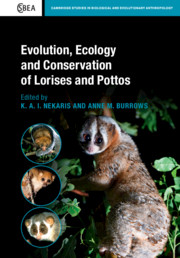Book contents
- Evolution, Ecology and Conservation of Lorises and Pottos
- Cambridge Studies in Biological and Evolutionary Anthropology
- Evolution, Ecology and Conservation of Lorises and Pottos
- Copyright page
- Dedication
- Contents
- Contributors
- Foreword
- Acknowledgements
- 1 Introduction
- Part I Evolution, Morphology and the Fossil Record
- Part II Ecology and Captive Management
- Part III Research, Trade and Conservation
- 24 Trapping, Collaring and Monitoring the Lorisinae of Asia (Loris, Nycticebus) and Perodicticinae (Arctocebus, Perodicticus) of Africa
- 25 Evaluation of Field Techniques Used to Assess Populations of Pottos and Lorises
- 26 Occupancy Modelling as a Method to Study Slender Loris Density
- 27 Using Accelerometers to Measure Nocturnal Primate Behaviour
- 28 Distribution and Conservation Status of Slow Lorises in Indo-China
- 29 Wildlife Trade Research Methods
- 30 Online Imagery and Loris Conservation
- 31 Slow Lorises (Nycticebus spp.) as Photo Props on Instagram
- 32 Integrating Science and Puppetry to Inspire Teenagers in Rural Asia to Value Slow Lorises
- 33 Developing a Rescue and Rehabilitation Centre as a Reaction to the Extensive Illegal Wildlife Trade in Slow Lorises
- References
- Index
33 - Developing a Rescue and Rehabilitation Centre as a Reaction to the Extensive Illegal Wildlife Trade in Slow Lorises
from Part III - Research, Trade and Conservation
Published online by Cambridge University Press: 29 February 2020
- Evolution, Ecology and Conservation of Lorises and Pottos
- Cambridge Studies in Biological and Evolutionary Anthropology
- Evolution, Ecology and Conservation of Lorises and Pottos
- Copyright page
- Dedication
- Contents
- Contributors
- Foreword
- Acknowledgements
- 1 Introduction
- Part I Evolution, Morphology and the Fossil Record
- Part II Ecology and Captive Management
- Part III Research, Trade and Conservation
- 24 Trapping, Collaring and Monitoring the Lorisinae of Asia (Loris, Nycticebus) and Perodicticinae (Arctocebus, Perodicticus) of Africa
- 25 Evaluation of Field Techniques Used to Assess Populations of Pottos and Lorises
- 26 Occupancy Modelling as a Method to Study Slender Loris Density
- 27 Using Accelerometers to Measure Nocturnal Primate Behaviour
- 28 Distribution and Conservation Status of Slow Lorises in Indo-China
- 29 Wildlife Trade Research Methods
- 30 Online Imagery and Loris Conservation
- 31 Slow Lorises (Nycticebus spp.) as Photo Props on Instagram
- 32 Integrating Science and Puppetry to Inspire Teenagers in Rural Asia to Value Slow Lorises
- 33 Developing a Rescue and Rehabilitation Centre as a Reaction to the Extensive Illegal Wildlife Trade in Slow Lorises
- References
- Index
Summary
Historical records of animal hunting by humans in Asia are at least 40,000 years old (Roberts et al., 2001). However, taking into account that the regional decline of many animal species has occurred over the past 50 years, it can be seen that this issue is still topical as animal hunting is currently the second most serious threat to wildlife (Corlett, 2007). While in ancient history humans hunted predominantly for the purpose of livelihood, present objectives of hunting have changed quite radically. The focus of hunting animals now is predominantly for sale as domestic ‘pets’, for traditional medicine purposes and for the sale of products made from them such as exotic leather products and other tourist curiosities (CITES, 2019). In Asia, hunting of animals for the purposes of magic and religion is also widespread (Shepherd et al., 2004). Hunting has become a major problem as a result of the high human population density and the major infrastructure developments that have made it easier to access not only forest areas (Nekaris et al., 2010b), but also distant urban markets with luxury products (often medicinal) (Corlett, 2007). The degree of utilisation of some plant and animal species is high, and the trade in them, along with the loss of natural habitat, damages their populations, which brings some species to the brink of extinction (CITES, 2019). Especially the illegal trade in wild animals and their products poses a big threat to species’ survival as this trade is estimated to be billions of dollars annually (Barber-Meyer, 2010; Wyler and Sheik, 2013).
- Type
- Chapter
- Information
- Evolution, Ecology and Conservation of Lorises and Pottos , pp. 393 - 403Publisher: Cambridge University PressPrint publication year: 2020
- 1
- Cited by



